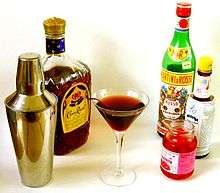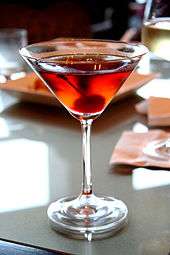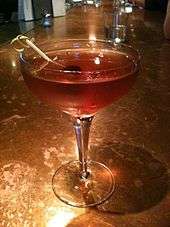Manhattan (cocktail)
A Manhattan is a cocktail made with whiskey, sweet vermouth, and bitters. While rye is the traditional whiskey of choice, other commonly used whiskies include Canadian whisky, bourbon, blended whiskey, and Tennessee whiskey. The cocktail is usually stirred then strained into a cocktail glass and garnished traditionally with a maraschino cherry.[1][2] A Manhattan may also be served on the rocks in a lowball glass.
| IBA official cocktail | |
|---|---|
 A classic 2:1 Manhattan, made with a whisky, sweet vermouth, bitters and a cherry | |
| Type | Cocktail |
| Primary alcohol by volume | |
| Served | Straight up; without ice |
| Standard garnish | Maraschino cherry |
| Standard drinkware | |
| IBA specified ingredients |
|
| Preparation | Stirred over ice, strained into a chilled glass, garnished, and served up. |
| Timing | Before Dinner |

The whiskey-based Manhattan is one of five cocktails named for a New York City borough. It is closely related to the Brooklyn cocktail,[3] which uses dry vermouth and Maraschino liqueur in place of the Manhattan's sweet vermouth, and Amer Picon in place of the Manhattan's angostura bitters.
The Manhattan is one of six basic drinks listed in David A. Embury's 1948 classic The Fine Art of Mixing Drinks.
Origin and history
Popular history suggests that the drink originated at the Manhattan Club in New York City in the mid 1870s, where it was invented by Dr. Iain Marshall for a banquet hosted by Jennie Jerome (Lady Randolph Churchill, mother of Winston) in honor of presidential candidate Samuel J. Tilden. The success of the banquet made the drink fashionable, later prompting several people to request the drink by referring to the name of the club where it originated—"the Manhattan cocktail".[4][5] However, Lady Randolph was in France at the time and pregnant, so the story is likely a fiction.[6]
However, there are prior references to various similar cocktail recipes called "Manhattan" and served in the Manhattan area.[5] By one account it was invented in the 1860s by a bartender named Black at a bar on Broadway near Houston Street.[7]
The original "Manhattan cocktail" was a mix of "American Whiskey, Italian Vermouth, and Angostura bitters".[8][9] During Prohibition (1920–1933) Canadian whisky was primarily used because it was available.[10]
An early record of the cocktail can be found in William Schmidt's The Flowing Bowl, published in 1891. In it, he details a drink containing 2 dashes of gum (gomme syrup), 2 dashes of bitters, 1 dash of absinthe, 2⁄3 portion of whiskey, and 1⁄3 portion of vermouth.[11]
The same cocktail appears listed as a "Tennessee Cocktail" in Shake 'em Up! by V. Elliott and P. Strong: "Two parts of whiskey, one part of Italian Vermouth, and a dash of bitters poured over ice and stirred vigorously."[12]
Traditions
On the small North Frisian island of Föhr, the Manhattan cocktail is a standard drink at almost every cafe, restaurant, and "get together" of locals.[13] The story goes that many of the people of Föhr emigrated to Manhattan during deep sea fishing trips, took a liking to the drink, and brought it back to Föhr with them. The drink is usually mixed 1 part vermouth to 2 parts whiskey, with a dash of bitters, served ice cold, in an ice cold glass, or with ice and a cherry garnish.
Variations

Traditional views insist that a Manhattan be made with American rye whiskey. However it can also be made with bourbon or Canadian whisky. The Manhattan is subject to considerable variation and innovation, and is often a way for the best bartenders to show off their creativity.[7] Some shake the ingredients with ice in a cocktail shaker instead of stirring it, creating a froth on the surface of the drink. Angostura is the classic bitters, but orange bitters or Peychaud's Bitters may be used. Some make their own bitters and syrups, substitute comparable digestifs in place of vermouth, specialize in local or rare whiskeys, or use other exotic ingredients.[7] A lemon peel may be used as garnish. Some add juice from the cherry jar or Maraschino liqueur to the cocktail for additional sweetness and color.
Originally, bitters were considered an integral part of any cocktail, as the ingredient that differentiated a cocktail from a sling.[14] Over time, those definitions of cocktail and sling have become archaic, as sling has fallen out of general use (other than in certain drink names), and cocktail can mean any drink that resembles a martini, or simply any mixed drink.
The following are other variations on the classic Manhattan:
- Black Manhattan – replaces vermouth with Averna.[15]
- Blonde Manhattan – made with 2 oz moonshine, 1 oz sweet vermouth, 0.5 oz orange liqueur, and 3 dashes of orange bitters.[16]
- Brandy Manhattan – made with brandy instead of whiskey, and is very popular in Wisconsin and Minnesota.[17]
- Cuban Manhattan – a perfect Manhattan (see below) with dark rum as its principal ingredient.[18]
- Dean Lyder – a twist on the perfect Manhattan, made with orange bitters and zest, giving it a 'big, bold character'. It is named for Courtney Lyder, dean of UCLA School of Nursing.[19]
- Dry Manhattan – made with dry vermouth instead of sweet vermouth, usually also replacing the maraschino cherry with a twist in keeping with the overall principle of reducing the cocktail's sweetness. A Manhattan made with dry vermouth but retaining the cherry rather than twist is sometimes known as a "half-dry Manhattan", but this name risks confusion with the perfect Manhattan, whose quantity of vermouth consists of equal parts sweet vermouth and dry vermouth.[7]
- Fanciulli – adds the bitter flavors of Fernet-Branca.[20]
- The Fourth Regiment – a classic (ca. 1889) cocktail that uses a 1:1 ratio of whiskey and vermouth, and uses three dashes of three different bitters – orange bitters, celery bitters, and Peychaud's Bitters.[21]
- Metropolitan – similar to a brandy Manhattan, but with a 3-to-1 ratio of brandy to vermouth and a dash of simple syrup.[22]
- Perfect Manhattan – made with equal parts sweet and dry vermouth.[7]
- Rob Roy – made with Scotch whisky.[7]
References
- Recipe for a Manhattan Cocktail from about.com
- http://mybestcocktails.com/recipe-21-Manhattan.html Recipe for a classic Manhattan Cocktail
- "The Brooklyn Cocktail Recipe". www.seriouseats.com. Retrieved May 26, 2020.
- Holiday Cocktail Party from CocktailTimes.com
- "Patrick Murphy's The Barman's Corner". Buckeye Tavern. 15 March 1945. pg. 6, col. 2. qtd. in "Moscow Mule; Molotov Cocktail; Manhattan Cocktail". The Linguist List. American Dialect Society. 28 October 2000. Archived from the original on 24 May 2008. Retrieved 2010-03-10.
- Winston Churchill, My Early Life
- Regan, Gary (September 21, 2007). "The Manhattan project: A bartender spills his secrets on the king of cocktails". San Francisco Chronicle. Retrieved 2007-09-21.
- Bonisteel, Sara (22 May 2006). "Tipplers Toast the Cocktail on Its 200th 'Anniversary'". Fox News Network. Retrieved 2010-03-10.
- "Manhattan". Cocktail Times. Retrieved 2007-09-21.
- "Manhattan". Retrieved May 26, 2020.
- Schmidt, A. William (1891). The Flowing Bowl: When and What to Drink.
- V. Elliott and P. Strong (1930). Shake 'em Up! (p. 39)
- Essen und Trinken from Föhr-Digital.de
- Levin, Steve (May 12, 2006). "The Origin of Cocktails". Pittsburgh Post-Gazette. Retrieved 2010-04-16.
- Black Manhattan Recipe, Imbibe May 31, 2016
- "Between the Sheets: Taliesin Jaffe". Retrieved May 26, 2020.
- "Cheers! Wisconsinites are the top consumers of brandy in the U.S." Mar 6, 2020. Retrieved May 26, 2020.
- "Manhattan". Great Cocktails. Retrieved 2007-10-22.
- Wright, Bekah (April 1, 2013) "The Lyder Side of Westwood", UCLA Magazine
- Simonson, Robert. "Fanciulli Manhattan Recipe". NYT Cooking. Retrieved 2020-05-06.
- "How to make the Fourth Regiment Cocktail – The Cocktail Spirit with Robert Hess". Archived from the original on 2013-04-27. Retrieved 2011-08-30.
- Felten, Eric (September 8, 2007). "In a League of Their Own: The Ivy League, That Is". The Wall Street Journal. Retrieved 2007-10-22.
External links
| Wikimedia Commons has media related to Manhattan (cocktail). |